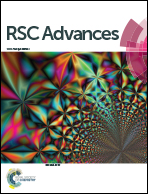Irradiation induced non-equilibrium phase formation and structural transformation in the Fe–Ti–Nb multilayered films
Abstract
Six sets of the Fe–Ti–Nb multilayered films were first prepared and then subjected to ion beam irradiation with 180 keV Xe ions. The unique amorphous phases, phase separation induced dual amorphous phase and orientation-preferred BCC–Fe crystalline phase were observed in these Fe–Ti–Nb multilayered films at different irradiation doses. In addition, it is also revealed that the Ti-rich HCP crystalline phase could transform into a metastable FCC phase in the Fe15Ti75Nb10 film. The possible mechanisms of these non-equilibrium phase formation and structural transformations are discussed based on atomic collision theory, geometric crystallography and ab initio calculations.


 Please wait while we load your content...
Please wait while we load your content...